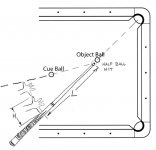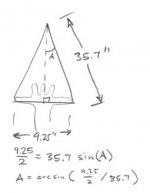Ok, so I lied a little in the title - this is an AUGMENTATION to the very popular "quarter ball aiming system". Basically the same system as SAM, and the billiards aim trainer system (http://www.billiardaimtrainer.com/). For more information about these systems, do a quick archives search or read up here:
http://forums.azbilliards.com/showthread.php?t=53774&highlight=aiming+template
http://forums.azbilliards.com/showthread.php?t=44853&highlight=aiming+template
So I have always had a little trouble estimating the cut angle to start with, so that when I thought it was supposed to be a half ball hit, I might be a bit off. So I present here, my method for determining the hit angle. Once you get calibrated, you could easily and quickly determine the angle to a few degrees precision!
A disclaimer: I MADE THIS SYSTEM UP MYSELF, using lots of external input from books, other people, and forum advise. There are probably lots of other people who have done something just like it, so I claim no property to it. I'd rather just share it freely, since I thought of it myself.
To recap the quarter ball aiming system: a 15 degree cut is called a 3/4 ball hit, a 30 degree cut is called a 1/2 ball hit, and a 45 degree cut is called a 1/4 ball hit.
Using my cue and my hand as a distance measuring tool, I used some basic trigonometry to come up with a very simple method to find those three angles. First some background info:
My father taught me very early a simple way to estimate length using my hand. All you have to do is hold your pinky and thumb stretched out as far as you can, and measure that span with a ruler. From then on, you can use your "hand span" as a unit of measure. My hand span is 9.25". Your hand size may vary. Yes, I also have big feet (reference: http://www.vendian.org/mncharity/dir3/bodyruler/)
(reference: http://www.vendian.org/mncharity/dir3/bodyruler/)
My pool cue is 58" long. The joint is 29" from the tip. The wrap begins 42" from the tip.
To use this system, you must first find your personal hand span distance, and using that then find your magic number. To find your magic number, multiply your hand span by 3.86. My hand span is 9.25, and my magic number is 35.7. Then you must locate a point on your cue that is exactly your magic number in inches from the tip of the cue. For me, it is a little more than halfway from the joint to the wrap (35.7 inches from the tip).
For me, a picture is a 1000 words, so take a look at the sketch of me measuring a 30 degree cut (1/2 ball hit). Then realize that one hand span = 15 degrees (3/4ball hit). three hand spans = 45 degrees (1/4ball hit). I have found this system to be VERY accurate, and fairly simple to execute on the fly.
What do you all think? I will follow this post with a few examples of where I find this system to be particularly useful.
Jon

http://forums.azbilliards.com/showthread.php?t=53774&highlight=aiming+template
http://forums.azbilliards.com/showthread.php?t=44853&highlight=aiming+template
So I have always had a little trouble estimating the cut angle to start with, so that when I thought it was supposed to be a half ball hit, I might be a bit off. So I present here, my method for determining the hit angle. Once you get calibrated, you could easily and quickly determine the angle to a few degrees precision!
A disclaimer: I MADE THIS SYSTEM UP MYSELF, using lots of external input from books, other people, and forum advise. There are probably lots of other people who have done something just like it, so I claim no property to it. I'd rather just share it freely, since I thought of it myself.
To recap the quarter ball aiming system: a 15 degree cut is called a 3/4 ball hit, a 30 degree cut is called a 1/2 ball hit, and a 45 degree cut is called a 1/4 ball hit.
Using my cue and my hand as a distance measuring tool, I used some basic trigonometry to come up with a very simple method to find those three angles. First some background info:
My father taught me very early a simple way to estimate length using my hand. All you have to do is hold your pinky and thumb stretched out as far as you can, and measure that span with a ruler. From then on, you can use your "hand span" as a unit of measure. My hand span is 9.25". Your hand size may vary. Yes, I also have big feet
My pool cue is 58" long. The joint is 29" from the tip. The wrap begins 42" from the tip.
To use this system, you must first find your personal hand span distance, and using that then find your magic number. To find your magic number, multiply your hand span by 3.86. My hand span is 9.25, and my magic number is 35.7. Then you must locate a point on your cue that is exactly your magic number in inches from the tip of the cue. For me, it is a little more than halfway from the joint to the wrap (35.7 inches from the tip).
For me, a picture is a 1000 words, so take a look at the sketch of me measuring a 30 degree cut (1/2 ball hit). Then realize that one hand span = 15 degrees (3/4ball hit). three hand spans = 45 degrees (1/4ball hit). I have found this system to be VERY accurate, and fairly simple to execute on the fly.
What do you all think? I will follow this post with a few examples of where I find this system to be particularly useful.
Jon

Last edited:
